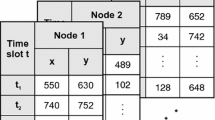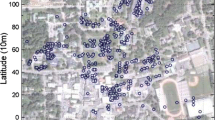Abstract
The complexity and variability of mobile social networks make protocol evaluation hard. Thus synthetic mobility models that well reflect the properties of human movement in real MSNs must be used in simulations. The overall objective of this paper is to design a pragmatic mobility model that comprehensively involves multiple factors that affect the choice of the next destination. The concept of Community Attraction is proposed as the selection criteria. It is related to three factors, that is, the distance of moving, the human relationships and the location restriction. Thus, our new mobility model is called Distance, Relationship, Location (DRL). Specifically, the former two factors are indicated through interaction matrices, which take the Social Relationship Attributes and the information of location as input. And we propose Location Attraction for the first time to denote the location restriction of a place. By the way, the value of Location Attraction is time varying. Moreover, the parameters that decide the weights of the factors in the formula of Community Attraction are derived by machine learning. And the learning method is called Bayesian Personalized Ranking algorithm. We load several protocols on DRL and the result shows that DRL correctly assesses their performance. To verify the reasonability of our model, we compare the simulation results of DRL with real traces, and they fit well.







Similar content being viewed by others
Notes
In this paper, ‘user’, ‘individual’ and ‘node’ have the same meaning. ‘user’ means the user of mobility devices in MSNs while ‘node’ is the abstract notion of the user. ‘individual’ is one of the users in a MSN.
In the following narrative, we sometimes simply call the users in a MSN ‘people’, ‘persons’ or ‘humans’.
References
Kayastha, N., Niyato, D., Wang, P., & Hossain, E. (2011). Applications, architectures, and protocol design issues for mobile social networks: A survey. Proceedings of the IEEE, 99(12), 2130–2158.
Royer, E. M., Melliar-Smith, P. M., & Moser, L. E. (2001). An analysis of the optimum node density for ad hoc mobile networks. In IEEE international conference on communications (vol. 3, pp. 857–861).
Tolety, V. (2002). Load reduction in ad hoc networks using mobile servers.
Davies, V. A., Vanessa, C., Davies, A., & Davies, V. A. (2000). Evaluating mobility models within an ad hoc network
Wang, S., Liu, M., Cheng, X., Li, Z., Huang, J., & Chen, B. (2013). Opportunistic routing in intermittently connected mobile P2P networks. IEEE Journal on Selected Areas in Communications, 31(9), 369–378.
Xiao, M., Wu, J., & Huang, L. (2014). Community-aware opportunistic routing in mobile social networks. IEEE Transactions on Computers, 63(7), 1682–1695.
Khalid, O., Khan, M. U. S., Khan, S. U., & Zomaya, A. Y. (2014). OmniSuggest: A ubiquitous cloud-based context-aware recommendation system for mobile social networks. IEEE Transactions on Services Computing, 7(3), 401–414.
Johnson, D. B., & Maltz, D. A. (1996). Dynamic source routing in ad hoc wireless networks. Mobile Computing, 353, 153–181.
Hong, X., Gerla, M., Pei, G., & Chiang, C. C. (1970). A group mobility model for ad hoc wireless networks (pp. 53–60).
Ng, J., & Zhang, Y. (2005). A mobility model with group partitioning for wireless ad hoc networks. In Third international conference on information technology and applications (vol. 2, pp. 289–294).
Kang, G. (2015). An group behavior Mobility model for opportunistic ad hoc networks. In Seventh international conference on ubiquitous and future networks, 2015 (pp. 186–190).
Musolesi, M., & Mascolo, C. (2007). Designing mobility models based on social network theory. ACM SIGMOBILE Mobile Computing and Communication Review, 11, 59–70.
Zheng, Y., Zhang, D., & Xie, K. (2016). A geography-intimacy-based algorithm for data forwarding in mobile social networks. Chinese Journal of Electronics, 25(5), 936–942.
Hsu, W. J., Spyropoulos, T., Psounis, K., & Helmy, A. (2007). Modeling time-variant user mobility in wireless mobile networks. In INFOCOM 2007—26th IEEE international conference on computer communications (pp. 758–766).
Karim, L., & Mahmoud, Q. H. (2013). A hybrid mobility model based on social, cultural and language diversity. In 2013 9th International conference conference on collaborative computing: Networking, applications and worksharing (pp. 197–204).
Ekman, F., Keränen, A., Karvo, J., & Ott, J. (2008). Working day movement model. In Proceedings of the 1st ACM SIGMOBILE workshop on mobility models (pp. 33–40).
Pholpabu, P., & Yang, L. L. (2015). Role playing mobility model for mobile social networks. In IEEE/CIC international conference on communications in China (ICCC), 2015 (pp. 1–6).
Karagiannis, T., Le Boudec, J. Y., & Vojnovic, M. (2010). Power law and exponential decay of intercontact times between mobile devices. IEEE Transactions on Mobile Computing, 9(10), 1377–1390.
Kosta, S., Mei, A., & Stefa, J. (2010). Small world in motion (swim): Modeling communities in ad-hoc mobile networking. In 2010 7th Annual IEEE communications society conference on sensor mesh and ad hoc communications and networks (SECON) (pp. 1–9).
Rendle, S., Freudenthaler, C., Gantner, Z., & Schmidt-Thieme, L. (2009). Bpr: Bayesian personalized ranking from implicit feedback. In Proceedings of the twenty-fifth conference on uncertainty in artificial intelligence (pp. 452–461).
Vahdat, A., & Becker, D. (2000). Epidemic routing for partially connected ad hoc networks. Tech. rep., Technical Report CS-200006, Duke University.
Lindgren, A., Doria, A., & Schelén, O. (2003). Probabilistic routing in intermittently connected networks. ACM SIGMOBILE Mobile Computing and Communications Review, 7(3), 19–20.
Spyropoulos, T., Psounis, K., & Raghavendra, C. S. (2005). Spray and wait: an efficient routing scheme for intermittently connected mobile networks. In Proceedings of the 2005 ACM SIGCOMM workshop on Delay-tolerant networking (pp. 252–259).
Acknowledgements
The authors would like to thank the support from the National Natural Science Foundation of China (Grant Nos. 61471028 and 61371069), the Specialized Research Fund for the Doctoral Program of Higher Education (Grant No. 20130009110015), and the financial support from China Scholarship Council.
Author information
Authors and Affiliations
Corresponding author
Rights and permissions
About this article
Cite this article
Jing, T., Zhang, Y., Li, Z. et al. DRL: A Multi-factor Mobility Model in Mobile Social Networks. Wireless Pers Commun 95, 1693–1711 (2017). https://doi.org/10.1007/s11277-016-3876-6
Published:
Issue Date:
DOI: https://doi.org/10.1007/s11277-016-3876-6




